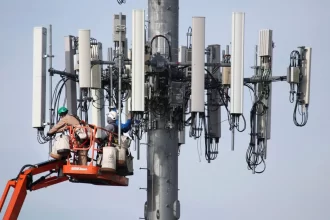The network security key is like a secret password for your Wi-Fi. It’s a code that makes sure only approved devices can connect to your wireless network. You need this key to connect your devices, like your computer or phone, to your Wi-Fi. It’s usually found on a sticker on your Wi-Fi router or in the settings if a device is already connected. It keeps your Wi-Fi safe and secure.
What is a Network Security Key?
A Network Security Key is like a secret code that protects your Wi-Fi network from unauthorized access. It’s also known as a Wi-Fi password or passphrase. This key ensures that only devices with the correct code can connect to your wireless network.
When you set up your Wi-Fi, you create this key to keep your network secure. It’s typically a combination of letters, numbers, and symbols. You need to enter this key when connecting a new device, like a computer or smartphone, to your Wi-Fi. The Network Security Key is crucial for maintaining the privacy and security of your wireless network.
Technology not only gives us cool stuff but also keeps our things safe. The security key is like a secret code that makes life easier and safer with technology. There are different types of security keys, and we use them for everyday things like online banking, buying stuff online, using the internet, and checking our email.
In simple words, the network security key is super important for daily things like money transactions, online shopping, logging into accounts, and more. It’s like a special key that makes our life simple and keeps our things safe.
Why do we need network security?

We use network security to keep our digital stuff safe from bad guys on the internet. It’s like a lock and key for our computer stuff. This way, only the people we say can use our things are allowed, and we don’t have to worry about our information getting into the wrong hands.
Without this protection, there’s a chance someone could sneak in and cause problems, like stealing our data or doing other harmful things. Network security is like a superhero guard for our online things, making sure they stay safe from possible dangers.
Security keys are like superheroes for the internet. They’re super important because the whole internet relies on them. The stronger and better the security key, the safer and more trustworthy the internet becomes, and more people use it.
These keys make sure that when we do things online, especially important stuff like money transactions, it’s done in a safe and protected way. Security keys also act like guards for the entire internet system.
They keep out anyone who’s not supposed to be there, protecting the whole network of computers. These keys are like shields for our data. They stop any bad stuff from getting in and messing with our system or all the connected computers.
When we have a security key, it means only the people we say can use our network or system. It’s like having a secret code that only lets in the right people.
Security keys also make sure that the things we share and use on the internet are real and safe. They check and control who gets to use what, so everything stays reliable and in good shape.
What are the Types of Network Security Keys?
There are several types of network security keys used to secure wireless networks. Here are the common ones:
- WEP Key (Wired Equivalent Privacy): An older and less secure type of key. It uses a fixed set of characters and can be easier to crack compared to more modern options.
- WPA Key (Wi-Fi Protected Access): More secure than WEP, it comes in two versions – WPA and WPA2. WPA2 is considered stronger and is recommended for better security.
- WPA3 Key: The most recent and advanced version of Wi-Fi security. It provides enhanced protection against various types of attacks and is designed to be more resistant to password-guessing attempts.
- PSK (Pre-Shared Key): This is a common type of key used in home networks. It’s the passphrase or password shared among users to access the Wi-Fi network.
- EAP (Extensible Authentication Protocol): Often used in enterprise environments, EAP is more complex and can involve additional layers of authentication, providing a higher level of security.
- Radius Server: In enterprise settings, a Remote Authentication Dial-In User Service (RADIUS) server may be used for authentication, generating dynamic and frequently changing security keys.
Remember that the choice of the network security key depends on the security protocols supported by your wireless router and devices. It’s generally recommended to use the latest and most secure options available, such as WPA3, to ensure the best protection for your network.
Where do I find network security key?
Here’s how you can find the network security key on different devices:
1. Windows
- Already Connected Device:
- Right-click on the Wi-Fi icon in the system tray.
- Select “Open Network & Internet settings.”
- Click on “Wi-Fi” and then on the connected network.
- Click on “Properties” and go to the “Security” tab. The network security key will be displayed in the “Network security key” field.
- Router Sticker:
- Check your Wi-Fi router for a sticker that contains the network name (SSID) and the network security key.
2. macOS
- Already Connected Device:
- Click on the Wi-Fi icon in the menu bar.
- Select “Open Network Preferences.”
- Click on the Wi-Fi network you are connected to.
- Click on “Advanced” and go to the “Wi-Fi” tab. The password will be shown.
- Keychain Access:
- Open “Keychain Access” (you can find it using Spotlight).
- In the search bar, type the name of your Wi-Fi network.
- Double-click on the network, check the box for “Show Password,” and enter your Mac’s username and password.
3. Android
- Already Connected Device:
- Open the “Settings” app.
- Go to “Connections” or “Network & Internet,” then “Wi-Fi.”
- Tap on the connected Wi-Fi network. The network details, including the password, will be displayed.
- Router Sticker:
- Check your Wi-Fi router for a sticker that contains the network name (SSID) and the network security key.
3. iOS
- Already Connected Device:
- Open the “Settings” app.
- Go to “Wi-Fi” and tap on the connected Wi-Fi network. The network password (key) will be displayed.
- Keychain Access:
- Unfortunately, iOS doesn’t provide a direct way to view saved Wi-Fi passwords. However, if you use iCloud Keychain, you can check on a Mac where the Wi-Fi password is saved.
Remember that displaying the Wi-Fi password on some devices may require administrative rights or the device’s passcode. If you can’t find it using these methods, you may need to access your router settings or contact your internet service provider for assistance.
Is a network security key the same as a password?
Yes, a network security key is essentially the same as a password when it comes to securing a Wi-Fi network. The terms are often used interchangeably.
The network security key, also known as the Wi-Fi password or passphrase, is a code that users need to enter when connecting their devices to a wireless network.
It serves as a form of authentication, ensuring that only authorized users can access the network. So, in the context of Wi-Fi networks, the network security key and password refer to the same thing.
Why is my laptop asking for network security key?
If your laptop is asking for a network security key, it means that you are trying to connect to a Wi-Fi network that is secured with password protection. The network security key is essentially the password for the Wi-Fi network.
Here are some common reasons why your laptop might prompt you for the network security key:
- Connecting to a New Wi-Fi Network: If you are connecting to a Wi-Fi network for the first time, or if you are in a new location, your laptop will ask for the network security key to ensure that you have permission to access the network.
- Changed Wi-Fi Password: If the owner of the Wi-Fi network changed the password, your laptop will prompt you for the new network security key the next time you try to connect.
- Network Security Key Not Saved: If your laptop hasn’t saved the network security key for a previously connected network, it will ask for it again when you try to reconnect.
To enter the network security key and connect to the Wi-Fi network:
- Go to your laptop’s network or Wi-Fi settings.
- Select the Wi-Fi network you want to connect to.
- Enter the network security key when prompted.
- Click or tap “Connect” to establish the connection.
Make sure you have the correct network security key, which is typically provided by the owner of the Wi-Fi network. If you are unsure, you can ask the network administrator or the person responsible for the Wi-Fi network for the correct key.
How do I change my network security key to password?
The terms “network security key” and “password” are often used interchangeably when referring to Wi-Fi networks. If you’re looking to change your Wi-Fi password or network security key, you’ll typically need to access your router’s settings. Here are general steps to guide you through the process:
- Access Router Settings:
- Connect your computer to the router either through a wired (Ethernet) connection or via Wi-Fi.
- Open a web browser and enter the router’s IP address into the address bar. Common addresses include 192.168.0.1 or 192.168.1.1. You can find the specific address in the router’s documentation or on a label on the router itself.
- Log in to the router. You may need to enter a username and password. If you haven’t changed these from the default, check the router’s manual for the default login credentials.
- Locate Wi-Fi Settings:
- Once logged in, navigate to the wireless or Wi-Fi settings section. The exact location may vary depending on your router model.
- Change Network Security Key (Password):
- Look for the field labeled “Network Security Key,” “Wireless Password,” or similar. This is where you can change the password.
- Enter your new desired password. Make sure it is strong and includes a mix of letters, numbers, and symbols for better security.
- Save or apply the changes.
- Reconnect Devices:
- After changing the network security key, all devices connected to your Wi-Fi will be disconnected. You’ll need to reconnect them using the new password.
- Update Network Settings on Devices:
- On each device that was previously connected to the Wi-Fi, go to the Wi-Fi settings and enter the new password.
It’s important to note that changing the network security key/password will disconnect all devices currently connected to the Wi-Fi, so you’ll need to update the password on all your devices afterward.
What is network security key on Wi-Fi?
The network security key on Wi-Fi is like a password that protects your wireless network. It’s a code that you set up to ensure that only authorized devices can connect to your Wi-Fi and access the internet. This key is also known as a Wi-Fi password or passphrase.
When you or someone else tries to connect a device (like a computer, phone, or tablet) to your Wi-Fi, they’ll need to enter this security key. The network security key is crucial because it helps keep your internet connection safe and prevents unauthorized people from using your Wi-Fi.
It’s a bit like a secret handshake that allows only the right devices to join your network. So, when you set up your Wi-Fi, you choose a strong network security key to maintain the security and privacy of your internet connection.
Conclusion
In conclusion, the network security key on Wi-Fi serves as a vital layer of protection for your wireless network. Functioning as a password or passphrase, it acts as a barrier, allowing only authorized devices to connect and use the internet.
This security measure is essential in safeguarding against unauthorized access, ensuring the privacy and integrity of your Wi-Fi network. By setting up a strong network security key, you enhance the security of your internet connection, promoting a safer and more controlled access environment for your devices.
Last word
We hope that this article has provided a clear understanding of what a ‘Network Security Key‘ is and why it holds significance. The blog encourages its readers to make use of network security keys for the security and benefits they offer.
By implementing and regularly updating network security keys, individuals can enhance the protection of their Wi-Fi networks, ensuring a safer and more secure online experience for all connected devices.
About Us
SEOByMasroor.Com, is the place where we make learning easy. We’re here to help you with simple and clear instructions for all the things you want to learn. We believe that everyone can learn. SEOByMasroor is here to help you become better at things and make life a little simpler.





